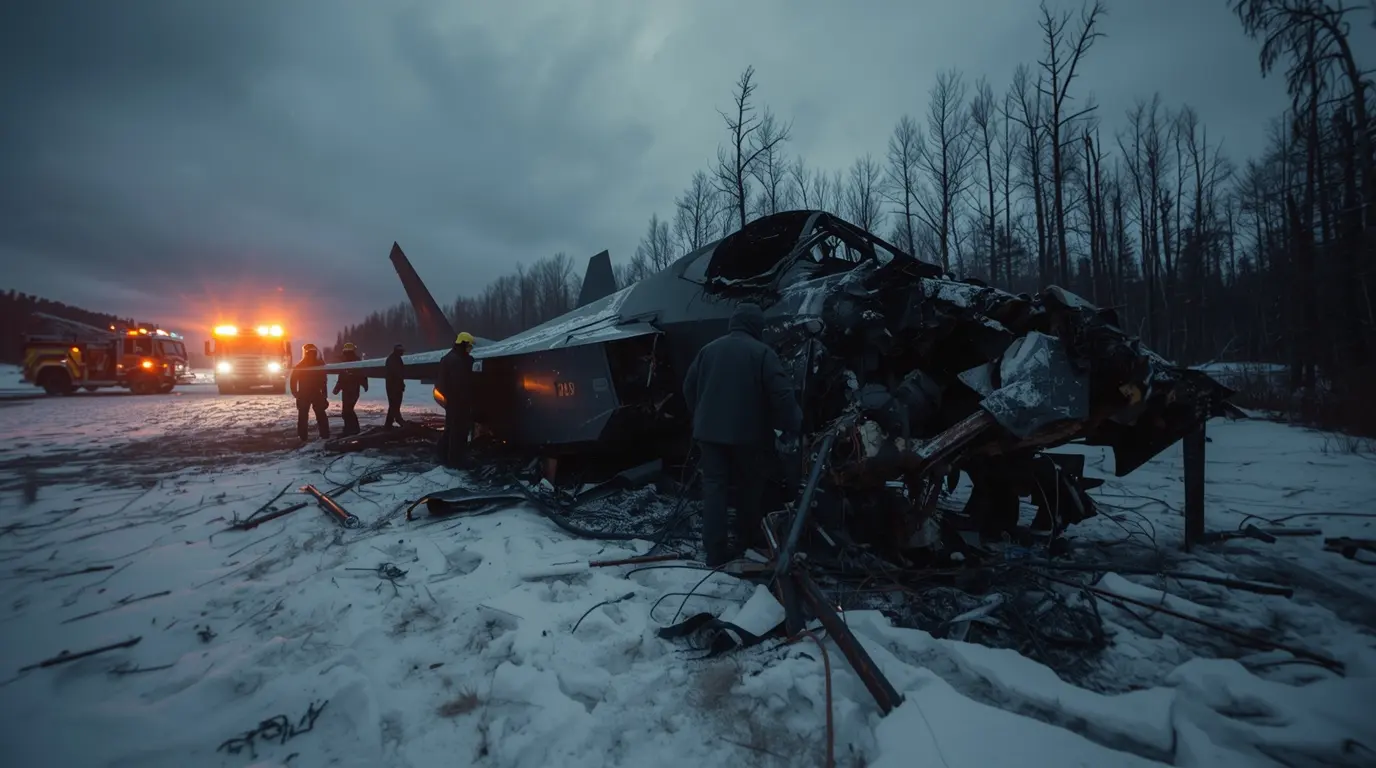Introduction
What should have been a standard training flight over Alaska suddenly turned deadly for one F-35 pilot. He called in system checks with engineers and stayed in the cockpit for 50 minutes while the fighter streamed trouble codes. Just seconds before the $200 million jet slammed onto the ice at Eielson Air Force Base, he punched out. The accident report, out last week, spells out a grim story: iced-over hydraulic circuits, old and contaminated fluid, tired checks by ground crews, and a bone-chilling Alaskan night forewarned that even the world’s best fighter can’t outrun snow, ice, or fatigue.
The Fateful Flight: A Timeline of the Mishap
It was a formation sortie, one of four, the familiar choreography of an A-1 sortie, one of four, the familiar choreography of an Air Force standard. The F-35 pilot, a veteran with 600 hours in type, climbed to 1,200 feet and clicked the gear handle to stow the big struts. The jet jolted, then squawked on the cockpit screen: gear not locked. He punched the button again. The two main wheels sucked up tight. The nose gear balked, rolling 17 degrees left and jamming in stubborn balance that lights up the fingers of a F-35 pilot’s warning klaxon.
The F-35 pilot went straight into a holding pattern over the base and set up a video conference with Lockheed Martin engineers. On the line were a senior software developer, a flight safety expert, and three landing-gear technicians. They kept the conversation with the F-35 Pilot going for almost 50 minutes while the jet cruised at 9,500 feet. They ran checklists and sketched out a landing plan, but forgot to ask for environmental data that might have pointed out ice formation, and they missed a key fault code from the left main-gear channel.

Next, the engineers told the F-35 pilot to try a series of touch-and-go landings. The nose-gear wheel needed a pop into its jammed lock, and they thought a quick runway bounce might do the trick. The first landing failed to reset the wheel. On the second, faster try, ice blocked the main-gear nose doors, locking the hydraulics from completing the extend sequence. The sensors that count weight on the wheels were fooled into thinking the jet had already touched down.
The F-35’s sophisticated controls unexpectedly switched to “automated ground-operation mode,” mistaking flying conditions for taxiing ones. This deception sent the fighter into odd oscillating movements the F-35 pilot couldn’t correct. At just 372 feet above the tarmac and at 222 knots, the seat ejected cleanly, leaving him with only bumps and bruises. The jet, meanwhile, climbed to 3,205 feet, went into a stall, and dove straight down, lighting the sky in a fireball later shared widely on social media.
Root Cause: A Cascade of Failures
The accident report tracked the trouble to hydraulic fluid in the nose and main gear struts tainted with water. One-third of the hydraulic fluid was frozen water, and the extreme cold caused it to freeze solid. When the gear couldn’t lock fully, a misleading sensor sent false signals to the computer, telling it the jet was on the ground.
Key Factors Behind the Crash:
Contaminated Hydraulic Fluid: Crews mishandled hydraulic barrels, leaving lids off and allowing humidity to seep in. This lapse at Kadena Air Base in Japan and other forward bases compromised the fluid the jets relied on for safe operations.
Extreme Cold Impact: Bitter sub-zero temperatures turned water-contaminated hydraulic fluid into ice, blocking downstream valves and setting off a chain reaction that drove multiple systems offline.
Staffing and Procedure Gaps: A lean maintenance crew, absence of a certified hazmat supervisor, and reliance on outdated repair guides hindered safe outcomes. Compounding that, aging hydraulic benches failed to adequately cleanse lines, leaving residues to freeze.
Missed Warning data: Attendees on the joint operations call did not list the relevant Lockheed Martin bulletin from April 2024. That release identified cold-climate misleading Weight of Water warnings that could mislead aircraft logic into keeping gear stowed. A brief search could have changed the emergency guidance.
System-Wide Signals and Patterns
This failure sharpens the attention on the F-35’s ability to operate safely in deep freeze. A follow-on failure nine days later at Eielson—different squadron, same flight control—was avoided only because the F-35 pilot landed with landing gear stowed but functioning hydraulics, confirming the sensor and logic anomalies are not single-ship events.
Given frequent historical alarms, operations in sub-Arctic theaters like Norway, Canada, and Finland must access study of hangar de-icing and pre-flight flushing, or booby-trapped residual water will refreeze when crews release gear and brakes. Overall flight data show 12 hull losses globally since 2018: a sharp reminder of the aircraft’s inability, to keep its goal of 80% availability from the platform.

Conclusion: Lessons Learned and Path Forward
The F-35 pilot who escaped this incident acted with remarkable professionalism, managing a tricky emergency and ejecting just in time to survive. Still, the mishap laid bare weaknesses in the aircraft, the processes governing it, and in F-35 pilot and crew readiness. From this event, we take three clear, actionable lessons. One: we must tighten maintenance rules for the hydraulic system whenever the thermometer drops. Even minor oversights in chill conditions can lead to shafting the jet’s mobility. Two: both flight crews and maintenance engineers need deeper instruction on the risks the Arctic can dish out. That knowledge must stick with every reservist and active member.
Last, we must treat flammables, cleaners, and hydraulic fluids with stricter protocols to thwart unwanted swaps or spills. Only then will we truly defend readiness. Changes are already in the pipeline, and the imprint of this incident will shape every F-35 brief for Arctic sortie. The loss of a $200 million asset scares the imagination, yet it sternly proves advanced engineering, disciplined as it is, can still fall victim to the chill and to purposeful lapses. The lessons that will trickle into every checklist and every refresh of training are the best tribute we can pay to the risks kept the F-35 pilot safe.
Source: https://edition.cnn.com/2025/08/27/us/alaska-f-35-crash-accident-report-hnk-ml
For more incredible stories of everyday news, return to our homepage.




